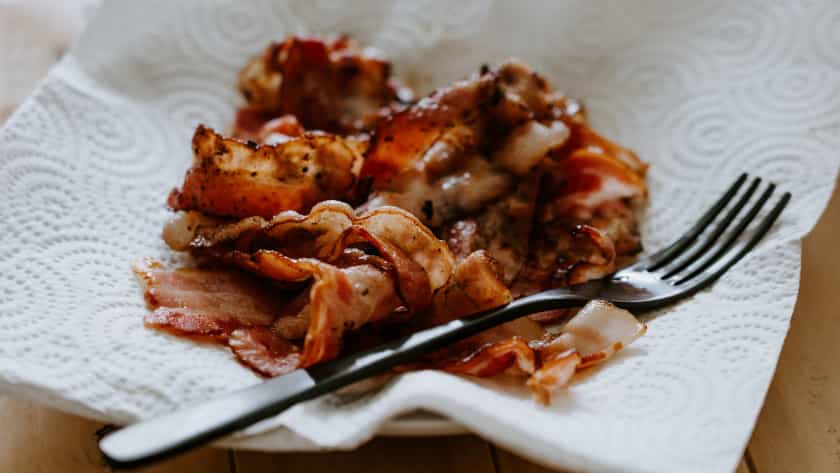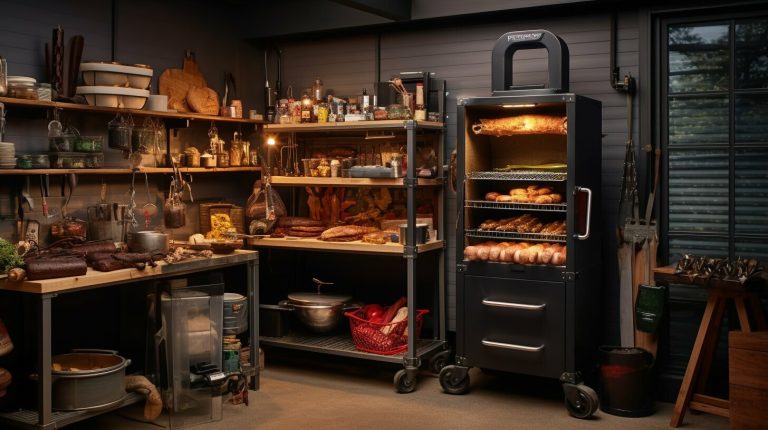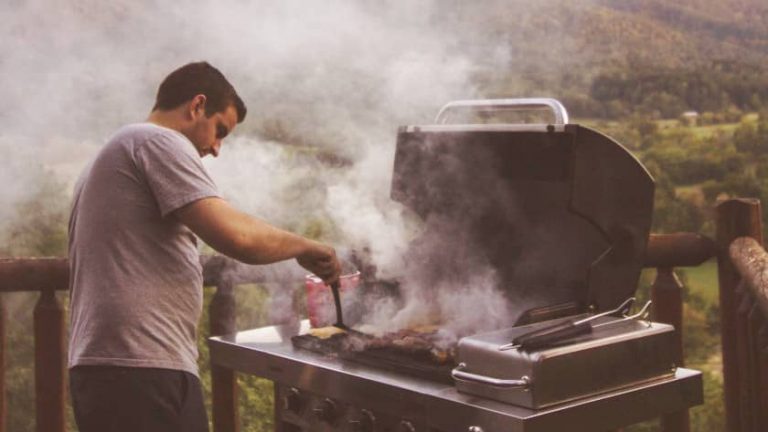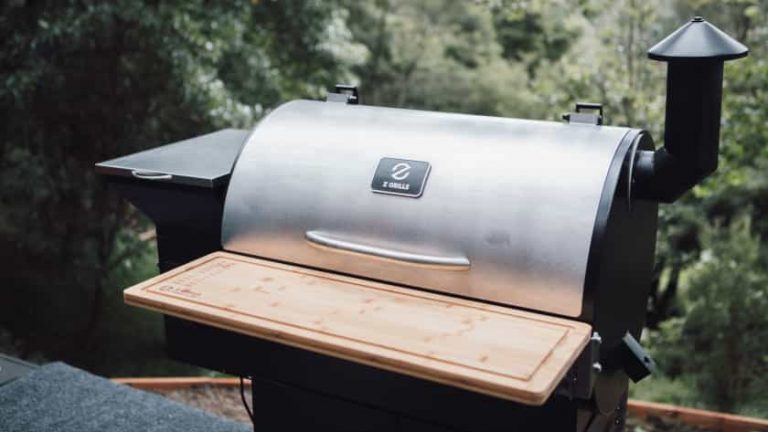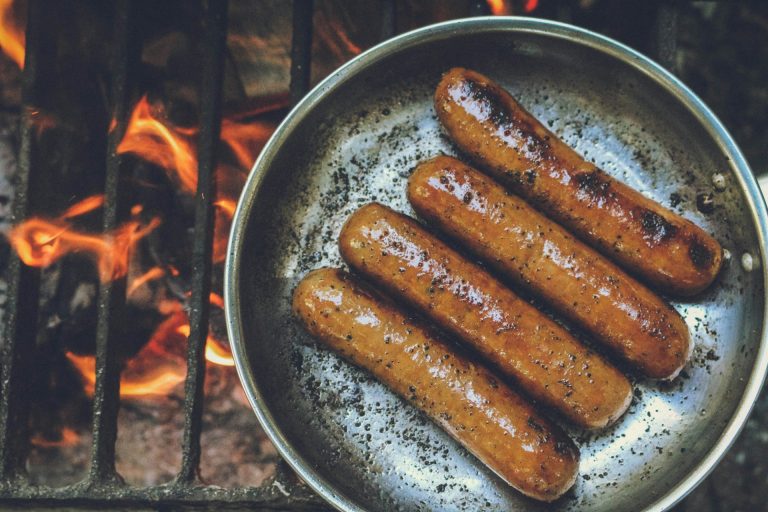Is Your Bacon Ready to Eat? Try These 5 Assessment Approach
If you’re like millions of people around the world, you’re a big fan of bacon. The key to enjoying bacon, however, is preparing it in the right manner.
If you want to make the most out of your salt-cured pork, then it’s critical to be able to identify accurately when it’s 100 percent ready to eat. Thankfully, these suggestions can help you easily and confidently do so.
What exactly does bacon that’s cooked look like? This type of bacon is often a tad crispy.
It’s often noticeably brown, too. If your bacon doesn’t fit this brief description in the slightest, then that may mean that your cooking journey isn’t totally complete.
Bacon Cooking Duration
Bacon cooking is in no way, shape or form a job that should ever require an enormous time commitment. Fortunately, bacon cooking also happens to usually be a relatively straightforward project.
People who are newbies to bacon preparation should acknowledge one thing, however.
Bacon has the tendency to burn pretty rapidly. If you want to excel in the fine art of bacon cooking, then you may have to deal with a little trial and error initially.
Bacon cooking duration can vary. They tend to correspond with how thick cuts of bacon are. They also tend to correspond with cooking techniques and cooker varieties as well.
In spite of that, bacon generally calls for anywhere between 20 and 30 minutes of total cooking time. This applies to the majority of bacon cooking situations, although there are undoubtedly departures.
It doesn’t matter if you’re baking your bacon, frying your bacon or perhaps even grilling it. If you give yourself approximately half an hour of work time, then you should probably be golden.
Don’t ever expect your cooking time to be shorter than approximately 20 minutes in total.
Is your cut of bacon on the thick side? If it is, then you should strive to cook it for anywhere between 30 and 45 minutes. If you’re cooking that’s thin inside, then you should try to cook it in the ballpark of 20 minutes.
How To Tell When Bacon Is Ready To Eat
Texture
It can be smart to assess bacon texture prior to doing anything else at all. If your bacon is cooked appropriately and thoroughly, then it should have a texture that’s nice and crisp.
Use a spoon or a knife to test the texture out. If your bacon has a dry and firm feel to it, then you’re probably in excellent condition. Take note of bacon that feels bizarrely soft.
If your meat has an overly mushy texture, then that’s a clue that you still have to continue cooking it for a short while; till its ready to eat.
Look at the surface of your bacon as well. Do you spot a thin layer of pale frothiness? If you do, then that can signify a texture that’s pleasantly crispy and therefore ready to eat.
Color
Bacon that is cooked in a thorough fashion takes on an entirely different color. It begins pink. When it’s cooked, it turns a distinct brown.
It can be wise to shut your stove off as soon as you realize that your bacon has taken on a pale brownish color. Pay close attention to any indications of burning, too.
If you spot any specific sections that are oddly dark, then that can point to burnt bacon.
You should never dismiss bacon that has a strangely deep brown color. That typically signifies bacon that’s cooked to an excessive degree. Bacon that isn’t cooked sufficiently, though, is a whole other story.
This kind of bacon may be pale brown. If you spot any parts of your bacon that are conspicuously white or pink in coloring, then it may denote meat that remains raw.
While bacon that’s deep brown is part of the overcooked category, bacon that’s basically black is essentially burnt.
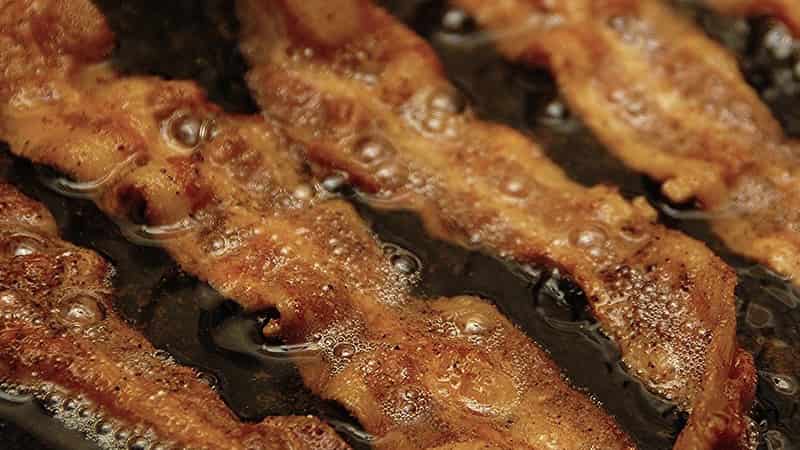
Size and Shape
Bacon that is done and ready to eat becomes an entirely different shape. Once you cook your bacon for a while, you’ll observe its edges starting to curve in a conspicuous way.
You should make sure that you refrain from shutting your stove or your gas off prior to verifying that the edges of your bacon have begun to curve. You should see to it that the sides curve in a consistent manner.
Don’t forget to zero in on size, either. If your bacon is done, then it should be a lot smaller. It should actually become roughly 40 percent smaller when all is said and done.
What makes this size change take place? It takes place due to the removal of the fat. Beyond that, it takes place as a result of the removal of any lingering water.
Moisture
The last thing you want to do is cease cooking bacon that still has a degree of moisture. If your bacon is completely cooked, then you should be able to spot a hint of oil, nothing more and nothing less.
It’s crucial to introduce appropriate levels of water and oil while you cook your meat. You should go above and beyond to emulate the steps that are part of your recipe’s instructions.
It can be a big mistake to introduce an excessive amount of water to your bacon. It can be just as huge a mistake to introduce insufficient amounts of it as well. Balance is always of the essence.
Grease
Grease can also help you pinpoint bacon that’s ready to eat. It can help you to concentrate on the level of grease that the meat has given off during cooking.
If your bacon is cooked entirely, then it should basically be immersed in grease. This specific grease is derived from the bacon cuts’ fat levels.
Many people appreciate the taste of bacon that has adequate grease. Cooking bacon in its fat can make it taste a lot more appealing to many fans of the meat.
You should look at both the top and the bottom “faces” of your bacon cuts.
Are they both concealed in a grease that’s pale and frothy? After the foam starts to develop, that can signify that you’re ready to turn the meat onto the other side.
Bacon flipping isn’t something that you have to do a lot. If you flip a cut one time, then that most likely is sufficient. If you opt for oven baking, then you do not have to flip your bacon over at all.
Bacon That’s Chewy
You don’t have to assume that you have to go for bacon that’s crispy. Although people often appreciate this sort of bacon, it’s in no sense the be-all and end-all.
If you notice that your bacon is a little chewy, then you can take your cuts out of the heat. There are some people who like chowing down on bacon that isn’t the crispiest, after all.
Why You Should Steer Clear of Ever Eating Bacon That Isn’t Sufficiently Cooked
You should never approach your bacon cooking lazily. That’s because the intake of undercooked bacon is not at all safe. If you chow down on bacon that’s raw or undercooked, then you may make yourself vulnerable to the possibility of food poisoning.
If you eat bacon that’s not “done,” then you may become a lot more susceptible to parasites, viruses, detrimental bacteria and foodborne illnesses in general.
A couple examples of diseases that are in many situations linked to the intake of bacon that’s undercooked are toxoplasmosis and trichinosis.
If you even suspect that your bacon may be raw, then you should never put it into your mouth. Don’t allow anyone you know to eat raw bacon, either. It’s not just a matter of simple taste and enjoyment. It’s a health issue.
Can You Use a Meat Thermometer For Bacon?
While with most meat you can use meat thermometer to know if its done and ready to eat; but since the bacon slices are too thin its really hard to get accurate results.
If your bacon slice is less than 1/2 inch thick then using meat thermometer won’t work for the same. Even if its more than 1/2 inch thick you should take multiple readings to avoid false positive.
Your bacon should be cooked at a min of 145 degrees Fahrenheit. As long as you know what you are doing and the bacon is sufficiently thick it’s fine to use an instant-read thermometer.
Take Your Bacon Cooking to the Next Level
Are you committed to the idea of becoming a bacon preparation aficionado? Do you want to say farewell to all doubts that involve whether your bacon is “done” and therefore ready to savor?
There are suggestions that can go a long way for you. It can be particularly effective to approach bacon cooking in an unhurried fashion. You don’t have to act like bacon preparation is a race.
Begin with your heat anywhere between low and medium in strength. Refrain from putting bacon that’s cold straight into a pan that’s extremely hot.
Try to wait until the bacon reaches the temperature on its own. Why exactly is this beneficial? It’s beneficial due to the fact that fat rendering isn’t something that takes place instantly.
Resist the urge to begin using a temperature that’s inordinately hot.
If you put time into rock-solid bacon cooking techniques, then you may be able to approach your preparation with a much higher degree of confidence and joy.
Don’t ever forget that practice makes perfect in the bacon preparation realm.
Related Post To Consider
Best Portable Pellet Grill For Camping Barbecue
What Part of the Cow is Beef Brisket? BBQ Beginners Guide
